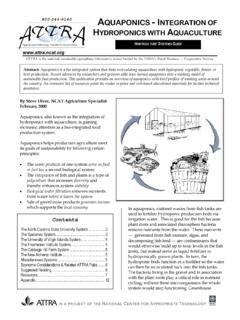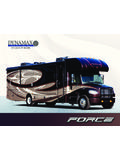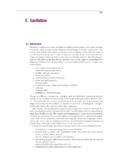Transcription of Lining the Raised Bed factsheet - Ecology Center
1 There are many reasons you might choose to build structures to grow vegetables, herbs, and other plants: To avoid toxics in soil such as lead or arsenic To avoid drainage problems that some soils can present To reduce back strain. Raised beds can be built at a good height for a wheelchair. To add an aesthetically pleasing feature in the garden To make it easier to add nutrients to the working layer of the soil To improve yields by reducing how much of the soil is walked on and compacted To clearly separate the growing area from pathways for easier weed control To enable gardening in paved spacesChoosing Your MaterialsWhen choosing materials for your Raised bed, consider durability, toxicity, environmental impact, affordability, aesthetics, maintenance requirements, and how permanent or portable you want your Raised bed to materials tend to be the most affordable.
2 Their environmental impact is low because they don t require forestry, mining, manufacture, or long-distance transport. Find free or low-cost materials on Craigslist or Freecycle, at your local salvage yard, or in your own backyard. The Ecology Center s EcoDirectory contains Bay Area resource listings, including local salvage low-tech method that saves money and has minimal environmental impact involves building a mound of soil and straw directly on top of the existing ground, without a structure to contain it. This method, which permaculturists favor, builds nutrients and adds tilth to impacted land. If your aim is to avoid toxics, this method might not be the Raised BedYou can line your Raised bed to make it more durable and to prevent toxics from leaching into the soil.
3 For Lining , use landscape fabric found at garden supply stores or cloth fabric from clothing. Avoid non-porous plastic, as it can retain too much water and discourage beneficial insects and worms. A Lining can make an existing Raised bed safer, but if your Raised bed is made of creosote railroad ties or arsenic-treated wood, it s best to remove the wood from the yard altogether to prevent continued migration of the toxics. To keep gophers and moles out of your plants, line the bed with metal hardware cloth or staple gopher/rat mesh to the bottom of the bed. Treated and Untreated WoodSome pressure treated wood is toxic, while some is not. The most toxic pressure-treated wood, chromated copper arsenate (CCA), can often be identified by its staple-like indentations and greenish tint, but not all types of CCA wood have these identifiers.
4 To make matters more confusing, wood pressure-treated with Alkaline Copper Quartenary (ACQ), which is considered safe, also appears green. If the wood was bought or the structure built prior to 2003, the lumber was most likely treated with toxic CCA. To be sure, buy an arsenic test kit from your local hardware store or your existing Raised beds were built with CCA-treated lumber, remove the structure to avoid the continued migration of arsenic through the yard. Even if the soil is replaced, the arsenic will migrate into the new soil. Dispose of the wood at a local waste facility as construction debris. If you choose to keep the bed, you may grow ornamental plants in it rather than food.
5 If you use untreated wood for your bed, use natural wood treatments like flaxseed oil or wax. Linseed oil can contain toxic additives, so it s best to avoid it. A wide variety of borate-based washes exist that are safer to use near food Raised BedsBuilding Raised | x 233 | Raised Bed DepthMake your Raised beds deep enough for healthy roots. Plants will be stunted and not produce well if their roots can t reach down far enough into soil. If the Raised bed is built shallowly, the roots will venture into the ground below unless it is too compacted. A floor or barrier is needed if you don t want roots growing into contaminated soil. The recommended soil depths at right are taken directly from Golden Gate Gardening by Pam - 10 inches: basil, beet, carrot short, chervil, chives, cilantro, lettuce, onion, greens, parsley, radish, peppermint, spinach, thyme, dwarf cherry tomato, watercress, oregano, sage, - 15 inches: carrot, celery, cabbage, garlic, chard, leek, lettuce, mustard, oregano, potato, strawberry, dwarf patio - 18 inches: beans, collards, cucumber, kale, pea, pepper, squash, short vine - 24 inches.
6 Broccoli, brussel sprouts, cabbage, corn, cauliflower, Raised beds (continued)Please consider supporting the Ecology Center s free educational resources at San Pablo Avenue, Berkeley, CA 94702 | x 233 | Essential Urban Farmer descriptions of building with urbanite, brick, stone, corrugated steel, and Vegetable Gardener s Book of Building Projects plans and building instructions for wooden Raised Tool Lending Library building and gardening tools available for those with a Berkeley library Toxics Coalition tips on growing food at home in a way that avoids toxics. Building Network arsenic wood hazards and alternatives.
7 Center EcoDirectory salvage yards, soil and compost sources. Materials for Raised BedsMATERIALENVIRONMENTAL IMPACTTOXICITY/LEACHINGDURABILITYCOSTNOT ESSoil/straw moundVery lowNoneLowFree to lowExplore permaculture (broken concrete pieces)Salvaged material has low noteHighFree to lowConcrete less than one year old can leach lime, affecting soil or cinderblockLow if reused, Medium if noteHighLow when reusedLining the bed can prevent lime from entering the logsLow if scrapNoneMedium to highFree to lowBambooEspecially low when grown domesticallyNoneMediumModerateMetal sidingLow if reusedLowMedium to highLow to highLine with fabric to delay treated reuse woodLowLowMedium to highModerateUse nontoxic sealant on untreated wood (Flaxseed oil or wax)Plywood, pressboard, and painted woodsHigh if new.
8 Lower if highMediumModerateAvoid. Contains toxic treated woodHighCan be highHighHighSee section on pressure treated or cedar (new)High, or lower if FSC (new)Can be very highLowHighHighPlastic lumberMedium ( does not decompose or recycle)ModerateHighHighHDPE and LPE are best plastic tiesHazardousVery highHighModerateAvoid due to toxic Books, Websites, and ResourcesPrinted on 100% post-consumer recycled paper





